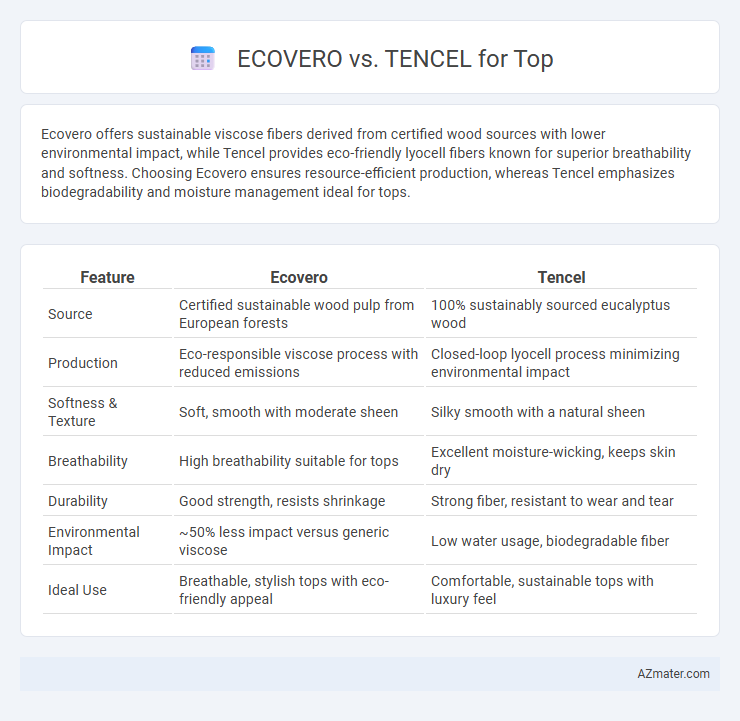Ecovero offers sustainable viscose fibers derived from certified wood sources with lower environmental impact, while Tencel provides eco-friendly lyocell fibers known for superior breathability and softness. Choosing Ecovero ensures resource-efficient production, whereas Tencel emphasizes biodegradability and moisture management ideal for tops.
Table of Comparison
| Feature | Ecovero | Tencel |
|---|---|---|
| Source | Certified sustainable wood pulp from European forests | 100% sustainably sourced eucalyptus wood |
| Production | Eco-responsible viscose process with reduced emissions | Closed-loop lyocell process minimizing environmental impact |
| Softness & Texture | Soft, smooth with moderate sheen | Silky smooth with a natural sheen |
| Breathability | High breathability suitable for tops | Excellent moisture-wicking, keeps skin dry |
| Durability | Good strength, resists shrinkage | Strong fiber, resistant to wear and tear |
| Environmental Impact | ~50% less impact versus generic viscose | Low water usage, biodegradable fiber |
| Ideal Use | Breathable, stylish tops with eco-friendly appeal | Comfortable, sustainable tops with luxury feel |
Overview: Ecovero vs Tencel for Sustainable Tops
Ecovero and Tencel are two leading sustainable fabrics widely used in eco-conscious clothing, especially tops, due to their environmentally friendly production processes. Ecovero, derived from certified sustainable wood sources with a lower environmental impact, offers excellent breathability and moisture regulation ideal for casual and activewear tops. Tencel, produced by Lenzing from sustainably sourced eucalyptus, beech, and spruce wood, provides superior softness and strength, making it a popular choice for premium, durable, and comfortable sustainable tops.
Fiber Origins: What Are Ecovero and Tencel?
Ecovero fibers are derived from sustainably sourced wood pulp, primarily from certified forests that follow strict environmental standards, ensuring reduced water and emissions during production. Tencel fibers are also crafted from sustainably harvested eucalyptus, beech, and spruce trees, produced through a closed-loop process that recycles water and solvents to minimize environmental impact. Both fibers are biodegradable and certified for responsible forestry, making them eco-friendly choices for sustainable fashion tops.
Production Process Comparison
Ecovero and Tencel fibers both originate from wood pulp but differ significantly in their production processes. Ecovero utilizes a closed-loop production method that recycles water and solvents, reducing environmental impact by up to 50% compared to conventional viscose. Tencel's lyocell process employs non-toxic solvents in a closed-loop system that recovers more than 99% of chemicals, ensuring minimal waste and low emissions.
Environmental Impact: Ecovero vs Tencel
Ecovero and Tencel fibers both prioritize sustainability but differ in their environmental impact due to production processes and resource management. Ecovero, made from certified sustainable wood pulp using a closed-loop process, generates up to 50% lower emissions and water impact compared to generic viscose. Tencel, produced by Lenzing with a proprietary closed-loop system, uses renewable wood sources and recycles 99% of water and solvents, minimizing waste and supporting sustainable forestry practices.
Breathability and Comfort for Tops
Ecovero fibers, derived from sustainably sourced wood pulp, offer excellent moisture management and breathability, making them ideal for tops worn in warm conditions. Tencel, produced by Lenzing, is known for its superior softness and moisture-wicking properties, enhancing comfort during prolonged wear. Both fibers provide eco-friendly options with Tencel slightly outperforming Ecovero in softness and moisture absorption, crucial factors for all-day comfortable tops.
Durability and Care Instructions
Ecovero and Tencel fibers both offer eco-friendly options for tops, but Ecovero tends to provide slightly better durability due to its manufacturing process using sustainable wood sources with minimal chemical use. Tencel, made from sustainably harvested eucalyptus trees, is known for its soft feel and breathability but requires gentler care instructions like cold washing and air drying to maintain fabric strength. Both materials are wrinkle-resistant and biodegradable, yet Ecovero's resilience to wear and simpler machine wash care makes it preferable for long-lasting tops.
Softness and Texture: Ecovero vs Tencel
Ecovero and Tencel both offer exceptional softness and smooth textures ideal for tops, with Tencel often praised for its silkier feel due to its lyocell fibers that enhance drape and comfort. Ecovero, made from sustainably sourced wood pulp, provides a slightly more textured surface, balancing softness with durability for everyday wear. Both fabrics excel in moisture absorption and breathability, making them perfect for soft, comfortable tops.
Style and Versatility in Top Designs
Ecovero fabric offers a sustainable option with a smooth texture and good drape ideal for elegant blouse designs and flowy tops, enhancing style versatility for casual to semi-formal wear. Tencel excels in softness and breathability, providing excellent moisture-wicking properties that suit activewear and everyday tops with a focus on comfort and sleek aesthetics. Both materials support diverse top designs, but Ecovero leans towards more structured, polished looks, whereas Tencel favors relaxed, breathable garments adaptable to various lifestyle needs.
Cost Differences and Availability
Ecovero fibers, derived from certified sustainable wood sources, typically cost less than Tencel fibers due to their more efficient production process and lower environmental impact fees. Tencel, produced by Lenzing from sustainably managed eucalyptus, beech, and spruce trees, is often priced higher because of its advanced closed-loop production system and strong brand recognition. Availability of Ecovero can be more regionally limited compared to Tencel, which benefits from broader global distribution and higher volume production capacity.
Which is Better for Tops: Ecovero or Tencel?
Ecovero and Tencel both offer sustainable fabric options for tops, but Tencel stands out for its superior softness, breathability, and moisture-wicking properties, making it ideal for comfortable and durable clothing. Ecovero, sourced from sustainably managed forests, excels in eco-friendly production with lower emissions and water usage, but may lack the same level of smoothness and drape that Tencel provides. For tops prioritizing comfort, performance, and a silky finish, Tencel is generally the better choice, while Ecovero suits consumers focused more on environmental impact.

Infographic: Ecovero vs Tencel for Top
 azmater.com
azmater.com